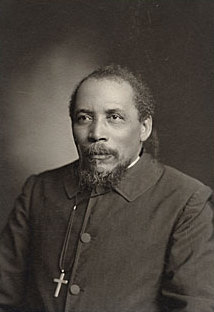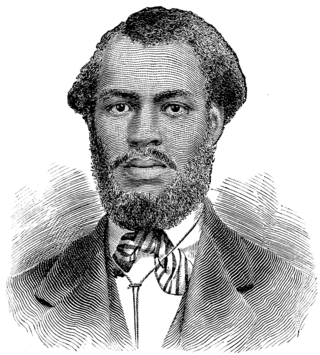
Blanche Kelso Bruce was born into slavery in Prince Edward County, Virginia, and went on to become a politician who represented Mississippi as a Republican in the United States Senate from 1875 to 1881. He was the first elected African-American senator to serve a full term.

Forty acres and a mule was part of Special Field Orders No. 15, a wartime order proclaimed by Union General William Tecumseh Sherman on January 16, 1865, during the American Civil War, to allot land to some freed families, in plots of land no larger than 40 acres (16 ha). Sherman later ordered the army to lend mules for the agrarian reform effort. The field orders followed a series of conversations between Secretary of War Edwin M. Stanton and Radical Republican abolitionists Charles Sumner and Thaddeus Stevens following disruptions to the institution of slavery provoked by the American Civil War. Many freed people believed, after being told by various political figures, that they had a right to own the land they had been forced to work as slaves and were eager to control their own property. Freed people widely expected to legally claim 40 acres of land. However, Abraham Lincoln's successor as president, Andrew Johnson, tried to reverse the intent of Sherman's wartime Order No. 15 and similar provisions included in the second Freedmen's Bureau bills.

The California Eagle (1879–1964) was a newspaper in Los Angeles, California for African-Americans. It was founded as The Owl in 1879 and later The Eagle by John J. Neimore. Charlotta Bass became owner of the paper after Neimore's death in 1912. She owned and operated the paper, renamed the California Eagle, until 1951. Her husband, J. B. Bass, served as editor until his death in 1934. In the 1920s, they increased circulation to 60,000. Bass was also active as a civil rights campaigner in Los Angeles, working to end segregation in jobs, housing and transportation.

Benjamin Sterling Turner was an American businessman and politician who served in the United States House of Representatives representing Alabama's 1st congressional district in the 42nd United States Congress.

African-American newspapers are news publications in the United States serving African-American communities. Samuel Cornish and John Brown Russwurm started the first African-American periodical called Freedom's Journal in 1827. During the antebellum South, other African-American newspapers sprang forth, such as The North Star founded in 1847 by Frederick Douglass.

Weldy Wilberforce Walker, sometimes known as Welday Walker and W. W. Walker, was an American baseball player. In 1884, he became the third African American to play Major League Baseball.

Richard Burton Fitzgerald was an American brickmaker and business man who lived in Durham, North Carolina. After building his enterprise, he became president of the black-owned Mechanics and Farmers Bank in Durham, and was involved in other business ventures throughout North Carolina. He served as first president of Coleman Manufacturing Company, established in 1897 as the first cotton mill in the United States to be owned and operated by blacks. His bricks were used for major construction projects in the state's largest cities, including the capital.
The civil rights movement (1865–1896) aimed to eliminate racial discrimination against African Americans, improve their educational and employment opportunities, and establish their electoral power, just after the abolition of slavery in the United States. The period from 1865 to 1895 saw a tremendous change in the fortunes of the black community following the elimination of slavery in the South.

The Bethel A.M.E. Church, known in its early years as Indianapolis Station or the Vermont Street Church, is a historic African Methodist Episcopal Church in Indianapolis, Indiana. Organized in 1836, it is the city's oldest African-American congregation. The three-story church on West Vermont Street dates to 1869 and was added to the National Register in 1991. The surrounding neighborhood, once the heart of downtown Indianapolis's African American community, significantly changed with post-World War II urban development that included new hotels, apartments, office space, museums, and the Indiana University–Purdue University at Indianapolis campus. In 2016 the congregation sold their deteriorating church, which will be used in a future commercial development. The congregation built a new worship center at 6417 Zionsville Road in Pike Township, Marion County, Indiana.
Weaver is an unincorporated community in Liberty Township, Grant County, Indiana. Weaver's first settlers were free people of color who migrated from North Carolina and South Carolina to Grant County in the early 1840s. The neighborhood was originally known as Crossroad; however, it was later renamed Weaver in honor of a prominent family of the community. The rural settlement reached its peak in the late 1800s, when its population reportedly reached 2,000. Many of its residents left the community for higher-paying jobs in larger towns during the Indiana's natural gas boom, but more than 100 families remained in the settlement in the early 1920s. Weaver, as with most of Indiana's black rural settlements, no longer exists as a self-contained community, but Weaver Cemetery remains as a community landmark.

James Milton Turner was a Reconstruction Era political leader, activist, educator, and diplomat. Appointed consul general to Liberia in 1871, he was the first African-American to serve in the U.S. diplomatic corps.

Richard W. Thompson was a journalist and public servant in Indiana and Washington, D.C. He was at various times an editor or managing editor of the Indianapolis Leader, the Indianapolis World, the Indianapolis Freeman and the Washington D.C. Colored American. He was published as a general correspondent in The Colored American, The Washington Post, the Indianapolis Freeman, the Indianapolis World, Atlanta Age, Baltimore Afro-American Ledger, the Cincinnati Rostrum, the Charleston West Virginia Advocate, the Philadelphia Tribune and the Chicago Monitor. His longest-lasting relationship was with the Indianapolis Freeman. In 1896, the black paper, The Leavenworth Herald, edited by Blanche Ketene Bruce, called Thompson the "best newspaper correspondent on the colored press."
Roberts Settlement was an early rural settlement in Jackson Township, Hamilton County, Indiana. Dating from the 1830s, its first settlers were free people of color, most of whom migrated from Beech Settlement, located 40 miles (64 km) southeast in rural Rush County, Indiana. Many of Roberts Settlement's early pioneers were born in eastern North Carolina and Virginia. Some of its settlers were ex-slaves. The neighborhood received its name from the large contingent of its residents who had the surname of Roberts. By the 1870s the farming community had a population of approximately 300 residents. In the late nineteenth and early twentieth centuries, the settlement's population began to decline, largely due to changing economic conditions that included rising costs of farming. Fewer than six families remained at the settlement by the mid-1920s. Most of Indiana's early black rural settlements, including Roberts Settlement, no longer exist. Roberts Chapel, listed on the National Register of Historic Places, serves as the site for the community's annual reunions of its friends and the descendants of former residents.
James Dallas Burrus was an American educator, druggist and philanthropist from Tennessee. He and a brother were among the first three graduates of Fisk University, the first African Americans to graduate from a liberal arts college south of the Mason–Dixon line. After completing graduate work in mathematics at Dartmouth College, Burrus became the first professor of mathematics at Fisk University. He later continued his teaching career at Alcorn Agricultural and Mechanical College in Mississippi.

Benjamin Tucker Tanner was an American clergyman and editor. He served as a bishop in the African Methodist Episcopal Church from 1886, and founded The Christian Recorder, an important early African American newspaper.

Robert James Harlan was a civil rights activist and politician in Cincinnati, Ohio in the 1870s-1890s. He was born a slave but was allowed free movement and employment on the plantation of Kentucky politician James Harlan, who raised him and may have been his father or half-brother. He became interested in horse racing as a young man and moved to California during the 1849 Gold Rush where he was very successful. In 1859 he moved to England to import racehorses from America and race them in England. He returned to the United States in 1869 during reconstruction. He became friends with Ulysses S. Grant and became involved in Republican politics. For the rest of his life, he was involved in city, state, and national African-American civil rights and political movements. In 1870 he became colonel of the Second Ohio Militia Battalion, a black state militia battalion in Cincinnati. In 1886, he became a member of the Ohio House of Representatives.

Marshall W. Taylor was a Methodist Episcopal minister and journalist in Kentucky. He is noted for his book, Collection of Revival Hymns and Plantation Melodies published in 1882. He was also the first black editor of the Southwestern Christian Advocate, a position he held from 1884 until his death in 1887.

R. C. O. Benjamin was a journalist, lawyer, and minister in the United States. He was an editor or contributor to numerous newspapers throughout the country, and may have been the first black editor of a white paper when he became editor of the Daily Sun In Los Angeles. He was also possibly the first black man admitted to the California bar, and may have been admitted to the bar in twelve states. In 1900 he was working as a prominent lawyer in Lexington Kentucky when he was beaten for helping register black voters by a white man who opposed his efforts. Later that day he was killed by the same man.
John J. Irvine was a railroad worker, engineer, and politician in Chattanooga, Tennessee. He was clerk of the circuit court of Chattanooga from 1886 to 1890 and he ran for mayor of the town in 1891. In 1899, he was a noted leader of a movement to establish an African-American colony in the Western United States.

George Levi Knox II was a U.S. Army Air Force/U.S. Air Force officer, combat fighter pilot and Adjutant with the all-African American 332nd Fighter Group's 100th Fighter Squadron, best known as the Tuskegee Airmen. One of the 1,007 documented Tuskegee Airmen Pilots, he was a member of the Tuskegee Airmen's third-ever aviation cadet class, and one of the first twelve African Americans to become combat fighter pilots. He was the second Indiana native to graduate from the Tuskegee Advanced Flying School (TAFS).















